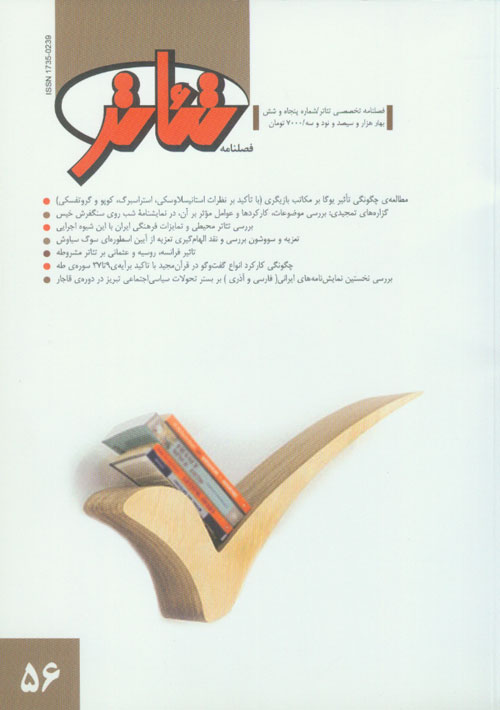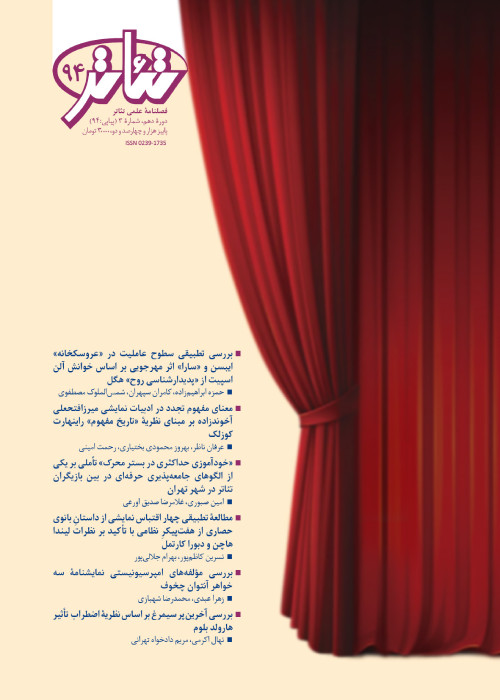فهرست مطالب

نشریه تئاتر
سال یکم شماره 56 (بهار 1393)
- 172 صفحه، بهای روی جلد: 70,000ريال
- تاریخ انتشار: 1393/12/10
- تعداد عناوین: 7
-
-
تعزیه و سووشون / بررسی و نقد اله ام گیری تعزیه از آیین اسطروه ای سوگ سیاوشصفحه 59
-
بررسی نخستین نمایش نامه های ایرانی (فارسی و آذری) / بر بستر تحولات سیاسی اجتماعی تبریز در دوره ی قاجارصفحه 145
-
Page 9The actors should regularly and continuously release their mind and body from tensions and contractions in the rehearsal process. In this article has been tried to investigate the reflection of Yoga in the opinions and experiences of four acting masters called Stanislavski, Grotowski, Jacques Copeau, and Strasberg. The investigation is based on the Yoga teachings and trainings, especially release, concentration, and breathe practices. This research that is descriptive-analytical by using the sources from library and internet for editing it will discussing these questions:1. How the Yoga teachings and trainings, especially release, concentration, and breathe practices have reflected in the methods and experiences of the acting masters?2. How had been the positive and the negative opinions of these four masters around the realm of using Yoga (In theatre)? 3. How these masters could take advantage of the concepts that are retrieved from Yoga -such as: release, breathe, and the relation of mind and body- in developing of their theoretical and practical knowledge? Finally the article has been proposed like this: The mentioned masters despite of their positive and negative view points to Yoga, had been all affected by it. They had all taken advantage of Yoga trainings, especially release and breathe practices of Yoga. These trainings would create a kind of harmony and balance between body and mind that would be effective in the process of body and mind release of actors and actresses.Keywords: Yoga, Release, Breath, concentration, Constantin Stanislavski, Jacques Copeau, Lee Strasberg, Jerzy Grotowski
-
Page 29Politeness is an important phenomenon in the social interactions, and although its definition, factors and limits are bound to the cultural contexts of the societies’, it can be regarded as a proper and appealing act which does not hurt others, and is shaped according the situations and feelings of the audience. Compliment is also a type of politeness strategies and a type of speech act, whose subject is approving or applauding the positive qualities of the participants in the dialogue. The ultimate goal of this article is collecting and analyzing the relevant data on compliment in Persian, and checking the effect of gender and social factors on them, as well as their function in the Persian dramatic texts. The reason why the play A Night on the Wet Cobblestone was chosen is the realist style of its writer (Akbar Radi), and the characters of this paly who are mostly the members of the elite level of the society, who naturally make lots of uses of compliments in their daily talks. The results of the data analysis of this play reveal that men have made use of compliments much more than women. Women’s compliments mostly have affective functions, and concern the characters of the audience, while men’s compliments have referential or informative functions, concerning with the skills and abilities of the hearer. Also, the decrease of the amount of compliments (especially the affective ones), and the use of sarcastic referential compliments can be regarded as a means for showing the clashes between the characters and approaching the point of crisis in drama.Keywords: Pragmatics, Politeness, Compliment, Akbar Radi, Shab Ruye Sangfarshe Khis (A Night on the Wet Cobblestone)
-
Page 47This article has attempted to achieve a correct definition of enviromental theatre and its characteristics to analyse and compare the cultural differences of this type of theatre with our culture. Researcher in this connection used Richard Schechner’s theories and techniques and examined the creation of enviromental theatre techniques from happening’s executive methods to finally be able to realize the role of culture and its differentation.Keywords: Performance, Theater, pluralism, enviromental Theater, Schechner
-
Page 59The dramatic quality of Tazieh is the most important artistic aspect of this ritual which has attracted the attention of the dramatic artresearchers. Therefore the researchers have been seeking sources from which Tazieh could be inspired. Some researchers have detected traces of the ancient mythical rituals of Iran such as Mourning for Siavashand demonstrate that Tazieh is inspired by it.There are very detailed and completely incidental similarities between these rituals and other analogous types such as the Christian religious medieval dramas in Europe, the Mesopotamian myths, the oriental theaters in India, China, etc. are considered by many to be the origin or contributing elements of the inspirations on Tazieh.These viewpoints are not substantiated by documents for verifying these claims.Tazieh, as the most important religious dramatic art of Iran and espoused by the religion and drawing on the Shiite mourning customs,has developed passing through some centuries of change since the emergence of Imam Hussein’s mourning rituals in 4th century up to the inception of verse performances in 12th and 13th centuries.The ups and downs indifferent stages of the formation of Taziehought to be studied and analyzed in the context of Shiitepolitical history.The political limitations ofShiite people and the enmity of the hostile rulers and caliphs with them as well as banning ofpromoting the message of the imams and prophet’s family caused the hindrance of the formation of Tazieh in the current form for centuries. Adopting this approach,the political and cultural objectives of Shia in the course of the history, the efforts for gaining more effective ways of conveyance of promoting the ideals of Ashura uprising, along with the literal and artistic capabilities of Shias, possessing historical sources, verse hymns, semi-dramatic verse cycles, narrative hymns, and the like in Persian as well as, the possibilities and capacities of the Karbala narrative for being turned into a dramatic performance are considered the most significant emerging grounds of Tazieh by Shias. Therefore, this removes the necessity of bringing up the subject of the inspiration of ancient mythical rituals on Tazieh.Keywords: Tazieh, ancient religious, Mourning for Siavash, ancient mythical
-
Page 83A lot has happened to the Iran’s theatre during the constitutional period; from the first invasion of Agha Mohammad khan Ghajar and decapitating Tiblisi’s actors, to forming theatre salons in Dar ol-fonoon and several translations of European texts. In the beginning, Iranian travelers and intellectuals became acquainted with the theater in the surrounding countries, such as Russia, and described its benefits and how-abouts through travel diaries. After a while, Nasser al din Shah was fascinated by theater, which marks the start of the European theater growth in Iran. The role of France, specially Moliere’s in the development of the European theatre in Iran is undeniable; from the first performance of Misanthrope at Dar olfonoon to the translation of all of his plays in those very early years. On the other hand, commute of the Russian, Caucasians and Turkish theater groups to Iran and their performances in the court and Dar ol-fonoon as well as introduction of opera to Iran paved the way for [further] establishing the European theater in Iran. Following these groups, Iranian intellectuals became eager to establish theatre troupes, imitating their practice. Meanwhile, we should refer to the role of Armenians in promoting this kind of theater. At the end of this article, we also mention the role of Habib Mirza in the translation movement.Keywords: Moliere, Travelers, travel diaries, Darolfonoon, Translation, First Theatre troups, Opera, Armenians, Mirza Habib
-
Page 121Effective communicating with others, particularly by dialogue, requires training, utilizing skills, ethics and etiquettes which include variant groups from family to society. The lack of this significant issue in relationship (whether by ignorance or weakness), causes cold and break out, ineffective and some time brings about tension and conflict. In this term, religious lessons, take heed to reasons, origins, impacts and specially dialogue etiquettes. Holy Quran is of books which consider dialogue issue via tale. Survey on verses; show us, dialogue factor was delivered to Muslims in various styles and frames inspiring variant messages to audiences (Muslims). Therefore, follow up and review this issue in Holy book can highlight many aspects of cultural discourse and specific knowledge of Islam and particular Quran. Dialogue classifications can help guidance for human beings and whereas these dialogues are quoted in terms of exemplary stories, can take a pattern from in all fields of thought, scientist, individual, social, politic and economic. Given that Quran is expression of all human being needs, searching and classify dialogues of this holy book would be worthy in order to applying its high contest to life. It should be understood that Quran discourses are divine revelation.Keywords: Quran, Variety of dialogue, the use of dialogue
-
Page 145During the late Qajar, especially the constitutional period, Tabriz as a center of innovation focus on various areas of modernity and the transformation and change of political, social and cultural, from the great uprising of sattar Khan and Bagher Khan to campaign for independence and liberation of Sheikh Mohammed Khiabani along with all those as a pioneer and innovator of new ideas and progressive social ethics like Talibov and Akhund zade... In the meantime Akhund zadeh and Mirza agha Tabrizi seeking for a literal form to transfer their reformist and radical thoughts. So the first Iranian plays were created. Iranian drama in its new genre written first by Akhund zadeh in Azari language. since the first plays written in the Persian language written by Mirza agha Tabrizi in Tabriz. It should be added that although it is highly influenced by the Akhund zada but his plays show the style and characterization is different from Akhund zade. This essay discusses the ideas and works of these two primers Iranian playwright in Tabriz, where is one of the most important centers of development of new theater as it is today, To evaluate the features and innovations of these first Persian playwrights and discuss their differences and similarities. In the end it is concluded that the dominant form which display a specific shape and ideal for social and political conditions of that time were play and drama Therefore these playwrights known as some of the main builders of the Constitutional Revolution. Finally, the paper finds that the characteristics of first plays in Iran causing a special form which is characterized in the literature. Including: Simplicity in writing, realism, characterization, and the subsequent of the logic of conversation and literary voice polyphony.Keywords: Akhund zadeh, Mirza agha Tabrizi.Tabriz, Constitutional literature, Iranian plays


